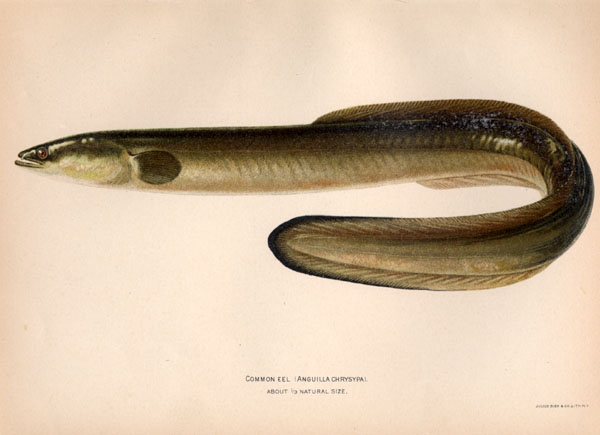|
Artist: A.Radclyffe Dugmore
Description Of Fish The common eel is familiar to every one who has lived in Eastern North America, and who has given any attention to things out doors. On our Atlantic Coast it ranges from Newfoundland to Mexico and Central America, and is also abundant among the islands of the West Indies. It is found likewise along the Gulf Coast. Unlike other eels it ascends freshwater streams long distances, and may be found even in the head- waters of nearly all the rivers of the Atlantic Coast and the Mississippi Valley. It is frequently found in lakes which would seem to be difficult to reach from the sea, but however great the barriers appear to be, it is certain that they have not been in- surmountable, and that the eels got into the lakes from some connecting water. The eel is really a freshwater fish, whose real home is in the freshwater rivers and lakes, but which runs down to salt water only at spawning time. Such fishes are called catadrornous species, and their movements at spawning time are in marked contrast with, and the exact opposite of, those of the anadromous fishes (such as the salmon and the shad) whose true home is in salt water, but which run up freshwater streams to spawn. The method of reproduction of the common eel was long a mystery, and even to this day it continues to be such among the illiterate and uninformed. While its method of reproduction has long been fully understood, scarcely a year passes that does not bring to the LJ. S. Fish Commission a communication from someone who claims that he has discovered that the lamprey—an animal belonging to an entirely different class from the eel, and only most remotely related to it—is really the female eel! The common eel spawns in salt water, usually off the mouths of rivers, on mudbanks, to which they go in great numbers at the spawning time, which is in the fall. On these mudbanks the eggs are laid, fertilization takes place, and the young eels develop within two or three months after hatching. At the beginning of the second spring these young find their way to mouths of the rivers, which they ascend in incredible numbers. In these freshwater streams and lakes they remain until of adult size, when they return to the sea for spawning purposes. This seaward migration takes place in the fall, at which time large numbers are caught in traps. During this migration, the eels, like the salmon and the shad, do not take any food. Having once reached the sea, they do not remain close to shore, but go out a distance to deeper water, where the development of the reproductive organs takes place very rapidly. This development is extraordinarily rapid when the immature state, in which the migrating eels are found, is considered; they probably become sexually mature within five or six weeks after reaching the sea. The spawning then takes place, after which both the old males and females die, never returning to fresh water the second time. The very unusual rapid development of their reproductive organs has such an effect upon the systems of the adult eels that they die soon after the act of reproduction. This is the reason that adult eels are never seen migrating up-stream. The down-stream movement occurs usually at night, commencing soon after sunset, is strongest from midnight to 2 o'clock a. m., and ceases an hour or more before sunrise. The common eel is remarkably prolific. The number of eggs produced by a single female 32 inches long has been estimated at 10,700,000. In the spring of the year thousands of young eels may be seen at the foot of waterfalls and dams, trying to make their way up stream. In their feeding habits eels are chiefly scavengers, feeding upon all manner of refuse, but preferring dead fish or other animal matter. They are a very undesirable inmate of rivers in which fish are caught in gillnets. It is said that the destruction of shad and herring by eels in the Susquehanna and other Atlantic coastal streams is enormous. It is not infrequent that when a gillnet is lifted the greater part of the catch consists simply of heads and backbones, the remainder having been devoured by myriads of eels in the short time the net was left out. The spawning shad is considered by them a special delicacy, and are often found emptied at the vent and completely gutted of the ovaries. Sometimes a shad, apparently full, is found to contain several eels of considerable size. The commercial value of the common eel as a food-fish has long been well established. It justly holds a high rank as an article of food among all who are familiar with it, and in the markets it always brings a good price. The eel is caught in all sorts of ways—in traps, eel-pots, seines, and on set-lines; and "bobbing for eels" is a classic in angling methods.
SIZE: Print size is 7 inches by 10 inches. CONDITION: Condition is fine. Blank on reverse. DATE: This print was made in 1902. |
